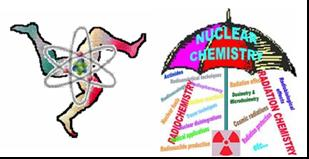Speaker
Prof.
Helen Papaefthymiou
(University of Patras)
Description
In this paper the 238U, 232Th, 226Ra, 40K and 137Cs activity concentrations in the marine sediments of Patras, Corinth and Amvrakikos Gulfs and Messolonghi lagoon complex, and their possible relation to geological, geochemical, biological and anthropogenic factors and processes are presented.
Patras Gulf is an open gulf with maximum depth of 160 m and due to its vicinity to Patras city (200.000 citizens) and harbour is contaminated with respect to port and urban activities. The Gulf of Corinth is a semi enclosed deep basin (max. depth 860m) which is connected to the Ionian Sea through the Patras Gulf. An aluminum processing plant discharges bauxitic red mud tailings into the northern margin and the central basin of the Gulf. The Amvrakikos Gulf is a semi-enclosed shallow (max. depth 65m) gulf which is connected to the Ionian Sea through narrow straits. Two major rivers discharge million of m3 freshwater into the Gulf. The Gulf is considered as the only fjord-like environment in Mediterranean Sea and is seasonally hypoxic/anoxic. Moreover, the Gulf has been heavily affected by the input of phosphate fertilizers over the last 25 years. The Messolonghi-Aetoliko lagoon complex, located in the northern coast of the Patras Gulf, is the most extended lagoon system in Greece and is considered as the most important wetland area.
The highest measured 238U, 232Th and 226Ra content was detected in the Gulf of Corinth due to the submarine bauxitic red mud deposits. Elevated 238U activity concentrations were observed in the Amvrakikos Gulf as a consequence of the pollution of the Gulf by the U-rich phosphate fertilizers. The highest activity concentrations of 137Cs were found in the Messolonghi lagoon and the Amvrakikos Gulf. These high activities are resulted of the runoff from the drainage areas at the northern margin of the Patras and Amvrakikos Gulfs, which have been heavily contaminated by 137Cs. Furthermore, the regional distributions of natural and man-made radionuclides interpreted on the basis of the geological, biogeochemical and anthropogenic factors of the surveyed areas.
Primary author
Prof.
Helen Papaefthymiou
(University of Patras)
Co-authors
Mr
Andreas Koutsodendris
(University of Patras)
Mr
Dimitris Athanassopoulos
(University of Patras)
Dr
Dimitris Christodoulou
(University of Patras)
Prof.
George Papatheodorou
(University of Patras)
Prof.
Maria Geraga
(University of Patras)
Mr
Nikolaos Vlachos
(University of Patras)
Ms
Stavroula Kordella
(University of Patras)
Mrs
Theano Karagiannidi
(University of Patras)




